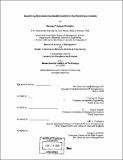Redefining manufacturing quality control in the electronics industry
Author(s)
Simington, Maureen Fresquez, 1970-
DownloadFull printable version (10.44Mb)
Other Contributors
Leaders for Manufacturing Program.
Advisor
Thomas W. Eager and Roy E. Welsch.
Terms of use
Metadata
Show full item recordAbstract
The most time consuming and capital intensive portion in the assembly of power electronic devices is the test system. A comprehensive test system including functional and stress screening technologies can significantly increase assembly times and more than double the capital investment required in a new assembly line. The primary purpose of the test system is to screen components for early life failures and to verify proper assembly. Determination of key performance characteristics and the resultant test system are developed during the product design phase and are seldom revised after the product has been released to manufacturing. This thesis explores best practices in testing methods and develops new methods to analyze test system performance. Both efforts were conducted in an effort to optimize existing test regimes. Upon completion of the above analyses the existing test sequence was reduced by 50%. This was primarily due to a discovery in the Burn In test cycle which indicated that failures correlated strongly with the on/off cycles inherent in the test sequence. A new test cycle was proposed to accommodate this finding and test results verified the initial hypothesis. Additionally, the summary of best practices identified new forms of product testing including Highly Accelerated Stress Testing (HAST), moving additional product testing into the development phase consequently reducing testing requirements during assembly.
Description
Thesis (S.M.)--Massachusetts Institute of Technology, Sloan School of Management; and, (S.M.)--Massachusetts Institute of Technology, Dept. of Materials Science and Engineering; in conjunction with the Leaders for Manufacturing Program, Massachusetts Institute of Technology, 2000. Also available online at the MIT Theses Online homepage <http://thesis.mit.edu>. Includes bibliographical references (p. 103).
Date issued
2000URI
http://theses.mit.edu/Dienst/UI/2.0/Describe/0018.mit.theses%2f2000-89http://hdl.handle.net/1721.1/34709
Department
Leaders for Manufacturing Program at MIT; Massachusetts Institute of Technology. Department of Materials Science and Engineering; Sloan School of ManagementPublisher
Massachusetts Institute of Technology
Keywords
Sloan School of Management., Materials Science and Engineering., Leaders for Manufacturing Program.